Coimbra
Coimbra
The medieval capital of Portugal for over a hundred years, and site of the country’s greatest university for the past five centuries, Coimbra wears its weighty importance in Portuguese history with dignity. Its atmospheric, historic core cascades down a hillside in a lovely setting on the east bank of the Rio Mondego: it's a multicoloured collage of buildings spanning nearly a millennium.
During the academic year, you’ll be sure to feel the university’s influence. On a summer evening, the city’s old stone walls reverberate with the haunting metallic notes of the guitarra (Portuguese guitar) and the full, deep voices of fado singers.
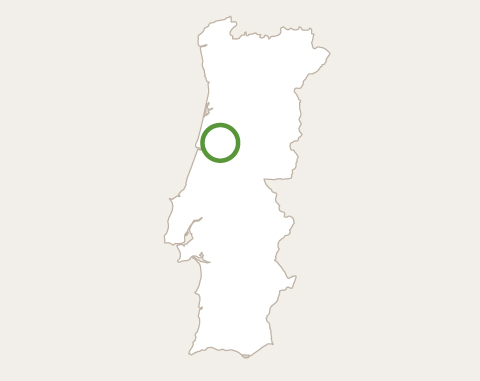
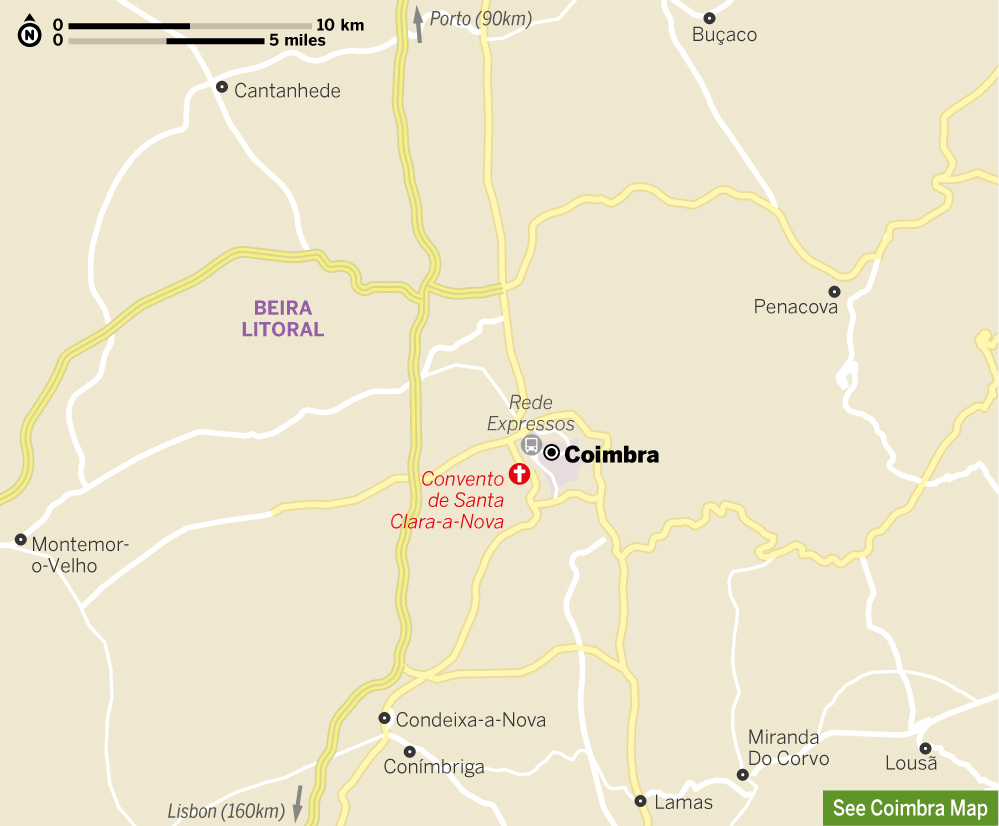
Coimbra in Two Days
Head straight up through the Old Town to the Velha Universidade, Coimbra's famous old university – it is the unrivalled highlight of any visit. Spend the rest of the day exploring the historical centre. Day two could be spent dipping in and out of Coimbra's old churches and monasteries and taking in a performance of the city's own version of fado.
Coimbra in Four Days
On day three it's time to get out of the city to explore the wonderful Roman ruins at Conímbriga, a short bus ride south. Your fourth day in Coimbra might be spent shopping for the city's distinctive pottery or hanging out with the students in some of the learned bars and clubs.
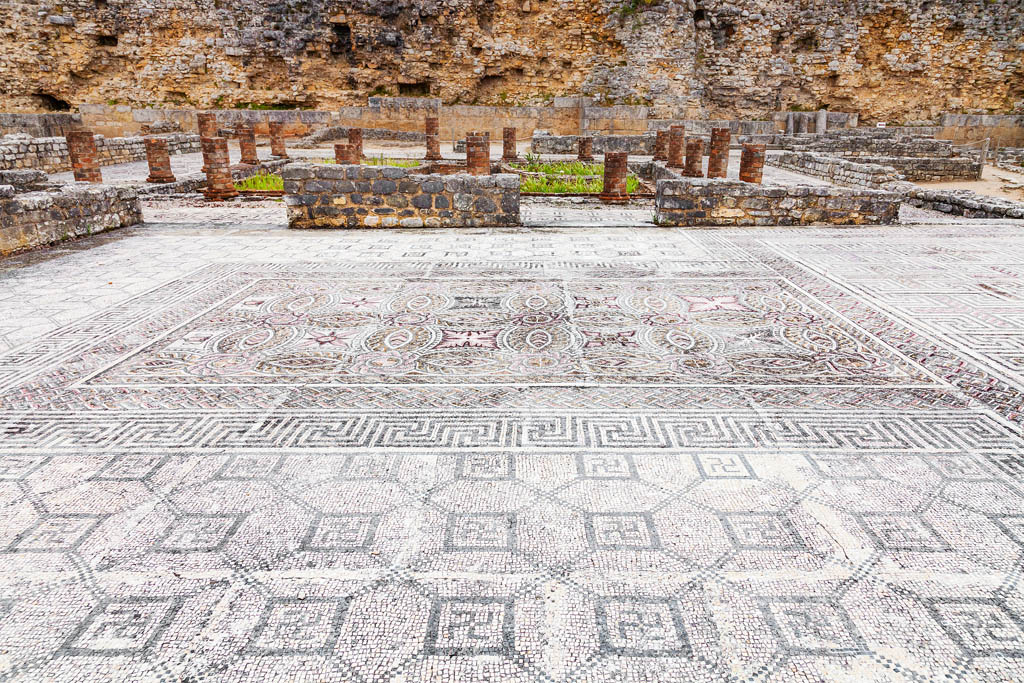
Arriving in Coimbra
Bus Station Handles intercity services across Portugal.
Coimbra B station Long-distance trains stop here.
Coimbra A station More central station handling local trains.
Sleeping
As one of Portugal's top tourist cities, Coimbra has plenty of places to stay. Most want to bed down in the thick of the Old Town action but there are many other options a short walk or bus ride from the centre.
TOP EXPERIENCE
Velha Universidade
Coimbra's main highlight is without doubt, the university nucleus, consisting of a series of remarkable 16th- to 18th-century buildings, all set within and around the vast Páteo das Escolas ('Patio' or courtyard).
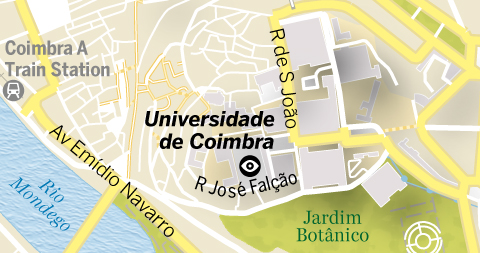
Great For…
 yDon't Miss
yDon't Miss
The view across Coimbra from the Páteo das Escolas is worth getting the camera out for.
 8Need to Know
8Need to Know
Universidade de Coimbra (
MAP
GOOGLE MAP
; ![]() %239 242 744; www.uc.pt/en/informacaopara/visit/paco; adult/student €9/7, tower €1;
%239 242 744; www.uc.pt/en/informacaopara/visit/paco; adult/student €9/7, tower €1; ![]() h9am-7.30pm mid-Mar–Oct, 9.30am-1pm & 2-5.30pm Nov–mid-Mar)
h9am-7.30pm mid-Mar–Oct, 9.30am-1pm & 2-5.30pm Nov–mid-Mar)
 5Take a Break
5Take a Break
Enjoy the view and the great food at central Loggia
 oTop Tip
oTop Tip
Visitors are only allowed into the library in small groups every 20 minutes.
There's a lot to see at the Velha Universidade so you should allow at least two hours. The sights include the Paço das Escolas (Royal Palace), clock tower, Prisão Acadêmica (prison), Capela de São Miguel (chapel) and the highlight of any visit to Coimbra, the Biblioteca Joanina (library).
Biblioteca Joanina
This extraordinary library, a gift from João V in the early 18th century, seems too extravagant and distracting for study, with its rosewood, ebony and jacaranda tables, elaborately frescoed ceilings and gilt chinoiserie bookshelves. Its 60,000 ancient books deal with law, philosophy and theology. A lower floor has more tomes and the Prisão Acadêmica, an erstwhile lock-up for misbehaving students.
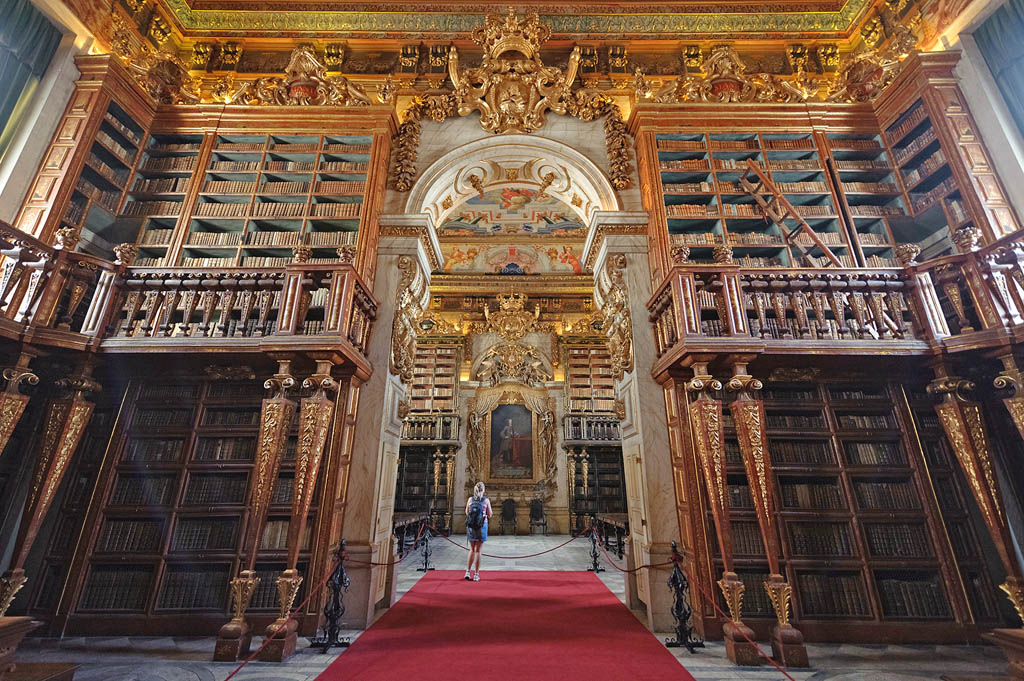
Capela de São Miguel
This extraordinarily beautiful, ornate baroque chapel has a brightly painted ceiling, ornate tilework, Manueline features and a gilded organ. It has been recently renovated. Concerts still take place here on occasion – ask at the turismo.
Other Attractions
The Schools Palace, the original Royal Palace, houses the university's iconic salas (rooms). Here, important traditional academic ceremonies still take place. To visit the palace, from the courtyard gate take the stairway on the right up to Sala dos Capelos, a former examination room hung with dark portraits of Portugal’s kings, and heavy quiltlike decoration. Nearby, is the private Examination Room, lined with paintings of the university rectors.The adjacent passageway affords visitors excellent city views. In fine weather, you may be permitted to enter the balcony, worth doing for fabulous vistas.
Another of the university's symbolic structures in Coimbra, the 18th-century tower – and its clock and bells – regulate academic life. Built between 1728 and 1733 on the premise that there could be no order without a clock, it was nicknamed 'a cabra' ('goat'; or 'bitch' in contemporary lingo), as it rang out to end the day's classes, signifying the curfew (in the days when students had to be home by 7pm or face prison). In fine conditions, you can climb the tower (€1).
Tickets & Tours
Buy your ticket at the university's visitor centre near the Porta Férrea. You can enter and explore on your own (with the exception of the library), or head off with a knowledgable university tour guide on one of three different tours (€12.50 to €20). These take place daily at 11am and 3pm.


Coimbra
1Sights
7Shopping
5Eating
1Sights
Crowning Coimbra’s steep hilltop is the university, around and below which lies a tangle of old town lanes. The new town, locally called ‘Baixa’, spreads at the foot of the hill and along the Rio Mondego.
Museu Nacional de Machado de CastroMuseum
(
MAP
GOOGLE MAP
; ![]() %239 853 070; www.museumachadocastro.pt; Largo Dr José Rodrigues; adult/child €6/free, cryptoportico only €3, with audio guide €7.50;
%239 853 070; www.museumachadocastro.pt; Largo Dr José Rodrigues; adult/child €6/free, cryptoportico only €3, with audio guide €7.50; ![]() h2-6pm Tue, 10am-7pm Wed-Sun Apr-Sep, 2-6pm Tue, 10am-6pm Wed-Sun Oct-Mar)
h2-6pm Tue, 10am-7pm Wed-Sun Apr-Sep, 2-6pm Tue, 10am-6pm Wed-Sun Oct-Mar)
This great museum is a highlight of central Portugal. It's built over the Roman forum, the remains of which can be seen and cover several levels. Part of the visit takes you down to the vaulted, spooky and immensely atmospheric galleries of the cryptoportico that allowed the forum to be level on such a hilly site. The artistic collection is wide-ranging and superb. The route starts with sculpture, from the architectural (column capitals) through Gothic religious sculpture and so on.
Highlights include a section of the delicate cloister of São João de Almedina and some exquisite alabaster pieces from England. Renaissance masters arriving in Coimbra from other parts of Europe brought their own styles and contributed to the establishment of a distinctive Coimbra tradition. A whole chapel has even been reassembled here. The section downstairs includes impressive 16th-century terracotta figures from Hodart's Last Supper, while paintings on the higher floors include stunning Flemish panels by Metsys. A collection of gold monstrances, furniture and Moorish-influenced pieces are almost too much by the time you reach them.

Museu da CiênciaMuseum
(
MAP
GOOGLE MAP
; ![]() %239 854 350; www.museudaciencia.org; Largo Marquês de Pombal; adult/student €5/3.50;
%239 854 350; www.museudaciencia.org; Largo Marquês de Pombal; adult/student €5/3.50; ![]() h10am-6pm Tue-Sun)
h10am-6pm Tue-Sun)
This wonderful science museum occupies a centuries-old former monastery converted by Pombal into the university’s chemical engineering building. It features intriguing state-of-the-art interactive science displays coexisting with 18th-century lab sinks; don’t miss the giant glowing globe in a room paved with medieval stones, or the psychedelic insect’s-eye view of flowers. Displays are in English/Portuguese. There's also a great cafe with terrace and views down to the new town.
The most extraordinary section, reopened in 2016, is housed in a building opposite (guided visits only). The collection displays 17th- to 19th-century teaching aids of the former physics and zoology study laboratories. Think curiosity cabinets and some of the most simple, ingenious scientific contraptions around (we love the centaur used to measure the direction and velocity of an arrow). Part of the joy, too, is observing the exquisite craftsmanship.
Sé VelhaCathedral
(Old Cathedral;
MAP
GOOGLE MAP
; ![]() %239 825 273; www.sevelha-coimbra.org; Largo da Sé Velha, Rua do Norte 4; €2.50;
%239 825 273; www.sevelha-coimbra.org; Largo da Sé Velha, Rua do Norte 4; €2.50; ![]() h10am-6pm Mon-Sat, 1-6pm Sun)
h10am-6pm Mon-Sat, 1-6pm Sun)
Coimbra's stunning 12th-century cathedral is one of Portugal's finest examples of Romanesque architecture. The main portal and facade are exceptionally striking. Its crenellated exterior and narrow, slit-like lower windows serve as reminders of the nation's embattled early days, when the Moors were still a threat. These buildings were designed to be useful as fortresses in times of trouble.
The church was financed by the first king of Portugal, Afonso Henriques. The high, barrel-vaulted nave preserves its main Romanesque features; side altars and well-preserved Gothic tombs of bishops are backed by bright Andalusian tiles. The high gilt retable is in ornate late-Gothic style and depicts the Assumption of Mary. Contrast this with the Renaissance Capela do Santíssimo Sacramento alongside. If you want to visit on a Sunday, note that Mass is at 11am.
Convento de Santa Clara-a-NovaConvent
(
GOOGLE MAP
; ![]() %239 441 674; www.rainhasantaisabel.org; Calçada de Santa Isabel; cloister €2;
%239 441 674; www.rainhasantaisabel.org; Calçada de Santa Isabel; cloister €2; ![]() h9am-6.45pm Mon-Fri Nov-Feb, 8.30am-7pm Mon-Sat, from 9am Sun Mar-Oct)
h9am-6.45pm Mon-Fri Nov-Feb, 8.30am-7pm Mon-Sat, from 9am Sun Mar-Oct)
Begun on higher ground in the 17th century to replace its flooded twin, this convent is devoted almost entirely to the saintly Queen Isabel’s memory. Aisle panels tell her life story, while her solid-silver casket is enshrined above the altar, and even her clothes hang in the sacristy. Her statue is the focus of the Festa da Rainha Santa (www.rainhasantaisabel.org).
Convento de Santa Clara-a-VelhaConvent
(
MAP
GOOGLE MAP
; ![]() %239 801 160; Rua das Parreiras; adult/student €4/2.50;
%239 801 160; Rua das Parreiras; adult/student €4/2.50; ![]() h10am-7pm Tue-Sun Apr-Sep, 10am-6pm Tue-Sun Oct-Mar)
h10am-7pm Tue-Sun Apr-Sep, 10am-6pm Tue-Sun Oct-Mar)
This Gothic convent was founded in 1330 by the saintly Dona Isabel, Dom Dinis’ wife; it served as her final resting place until flooding forced her to be moved uphill. The adjacent museum displays archaeological finds and shows two films, one about the nuns who lived here, the other documenting the 20-year renovation that cleared the river ooze that had drowned it since the 17th century.
Jardim BotânicoGardens
(
MAP
GOOGLE MAP
; ![]() %239 855 233; www.uc.pt;
%239 855 233; www.uc.pt; ![]() h9am-8pm Apr-Sep, 9am-5.30pm Oct-Mar)
h9am-8pm Apr-Sep, 9am-5.30pm Oct-Mar)
A serene place to catch your breath, the lovely university-run botanic garden sits in the shadow of the 16th-century Aqueduto de São Sebastião. Founded by the Marquês de Pombal, the garden combines formal flowerbeds, meandering paths and elegant fountains.
The green-fingered can also visit the lush greenhouses (closed at the time of research) and the adjacent Museu Botânico, while Skygarden has a series of ziplines here.
Conímbriga Roman RuinsRuins
(ruins & museum adult/child €4.50/free; ![]() h10am-7pm)
h10am-7pm)
In the rolling country southwest of Coimbra, Conímbriga boasts Portugal’s most extensive Roman ruins, one of the best-preserved sites on the Iberian Peninsula. It tells the poignant tale of a town that, after centuries of security, was split in two by quickly erected walls and then entirely abandoned as the Roman Empire disintegrated.
Elaborate mosaics, heated baths and fountains evoke toga-clad dalliances. Through the middle of this runs a massive defensive wall, built in haste to fend off raids.
Sé NovaCathedral
(New Cathedral;
MAP
GOOGLE MAP
; ![]() %239 823 138; www.senova.do.sapo.pt; Largo da Sé Nova; €1;
%239 823 138; www.senova.do.sapo.pt; Largo da Sé Nova; €1; ![]() h8.30am-6.30pm Mon-Sat, 10am-12.30pm Sun)
h8.30am-6.30pm Mon-Sat, 10am-12.30pm Sun)
The large, severe 'new' cathedral, started by the Jesuits in 1598 and completed a century later, dominates the square of the same name high in the old town. Its sober Renaissance lines contrast with the gilt side panels and ornate baroque altarpiece. Down the side is a gallery of reliquaries featuring bones and worse from minor saints and bishops, including St Francis Xavier, and St Luke (so it is claimed!). Climb to the platform for uplifting city views.
2Activities
SkygardenZipline
(
MAP
GOOGLE MAP
; ![]() %910 230 797; www.skygardenadventure.com; Calçada Martim de Freitas; adult/child €17/13;
%910 230 797; www.skygardenadventure.com; Calçada Martim de Freitas; adult/child €17/13; ![]() h10am-8pm Tue-Sun Apr-Sep, 10am-5.30pm Tue-Sun Mar & Oct, weekends only Nov & Feb)
h10am-8pm Tue-Sun Apr-Sep, 10am-5.30pm Tue-Sun Mar & Oct, weekends only Nov & Feb)
It's not what you might associate with a historic seat of learning, but for an education of a different kind, you can fly through the lush green of the Jardim Botânico on a 200m valley slide, climb ropes or 'free fall' from an ancient tree.
History
The Romans founded a city at Conímbriga, though it was abruptly abandoned in favour of Coimbra’s more easily defended heights. The city grew and prospered under the Moors, who were evicted definitively by Christians in 1064. The city served as Portugal’s capital from 1139 to 1255, when Afonso III decided he preferred Lisbon.
The Universidade de Coimbra, Portugal’s first university (and among the first in Europe), was actually founded in Lisbon by Dom Dinis in 1290 but settled here in 1537. It attracted a steady stream of teachers, artists and intellectuals from across Europe. The 16th century was a particularly heady time thanks to Nicolas Chanterène, Jean de Rouen (João de Ruão) and other French artists who helped create a school of sculpture here that influenced styles all over Portugal.
Today Coimbra’s university remains Portugal’s most prestigious – and one of its most traditional. Students still attend class in black robes and capes – often adorned with patches signifying course of study, home town or other affiliation – while a rigorously maintained set of rites and practices called the codigo de praxe governs all aspects of student life.
TTours
Go WalksWalking
(
MAP
GOOGLE MAP
; ![]() %910 163 118; www.gowalksportugal.com; Rua do Sargento Mor 4-6; from €12.50)
%910 163 118; www.gowalksportugal.com; Rua do Sargento Mor 4-6; from €12.50)
Various themed walking tours – from fado to Jewish Coimbra – run by enthusiastic, knowledgable students who speak good English (French and Spanish also bookable).
Tuk a DayTours
(
MAP
GOOGLE MAP
; ![]() %962 826 855, 964 486 445; per person €10;
%962 826 855, 964 486 445; per person €10; ![]() h9am-1pm & 3-7pm)
h9am-1pm & 3-7pm)
Travellers love the passionate Sr Amando and his informative, amusing 1¼-hour tours of Coimbra. He speaks many languages (around five at last count) and knows a lot. Minimum three people (or €30). Tours begin at the Portagem.
7Shopping
Carlos TomásCeramics
(
MAP
GOOGLE MAP
; ![]() %239 812 945; carlostomas_ceramicaartesanal@hotmail.com; Largo da Sé Velha 4)
%239 812 945; carlostomas_ceramicaartesanal@hotmail.com; Largo da Sé Velha 4)
Lovely hand-painted ceramics (and more) by Senhor Tomás. Will even do custom-made orders of your own design.
Student Party
In the first week of May, Coimbra marks the end of the academic year with Queima das Fitas, a week-long party that serves as the country’s biggest and best excuse to get roaring drunk. Literally, the name means ‘Burning of the Ribbons’, because graduates ritually torch the colour-coded ribbons worn to signify particular courses of study.
In the wee hours of Friday morning, the Queima kicks off with the Serenata Monumental, a hauntingly beautiful midnight fado performance on the steps of the Sé Velha. The agenda continues with sports events, private black-tie balls, nightly concerts at the so-called Queimodromo across the Ponte de Santa Clara, and a beer-soaked Sunday-afternoon parade called the Cortejo dos Grelados that runs from the university down to Largo da Portagem.
In their rush to sponsor the various festivities, Portuguese breweries provide ultracheap beer, which is distributed and drunk in liberal quantities.

5Eating
The atmospheric narrow streets between Praça do Comércio and Coimbra A train station are full of characterful, older-style Portuguese eateries; just wander down here and smell what's cooking. Many contemporary tapas-style places have opened in the old town (better for vegetarians). There's something to suit all budgets.
Tapas Nas CostasTapas$$
(
MAP
GOOGLE MAP
; ![]() %239 157 425; www.tapasnascostas.pt; Rua Quebra Costas 19; tapas €3.50-6.60;
%239 157 425; www.tapasnascostas.pt; Rua Quebra Costas 19; tapas €3.50-6.60; ![]() hnoon-midnight Tue-Sat)
hnoon-midnight Tue-Sat)
The 'hot spot' about town at the time of research, this sophisticated tapas joint delivers delicious tapas. Decor is stylish, as are the gourmet-style goodies, such as ovo com alheira de caça e grelos (sausage with turnip greens and egg; €5.60). What are 'small-to-medium' sized servings for Portuguese are possibly 'normal' for anyone else, so share plates are a satisfying experience.
A good list of wholly Portuguese wines. Reserve ahead.
Cafetaria Museu da CiênciaCafe$
(
MAP
GOOGLE MAP
; ![]() %910 575 151; Rua dos Estudos; light meals €4-9;
%910 575 151; Rua dos Estudos; light meals €4-9; ![]() h10am-6.30pm;
h10am-6.30pm; ![]() v)
v)
Tucked away in a remote part of the top of town, the science museum's cafe offers a large interior warmed by a log fire and an excellent terrace with views over the town below. Its light meals include quiches, salads and juices. It's renowned for its fabulous weekend breakfasts (from 11.30am to 4.30pm; €14.30). Daily plates Monday to Friday cost €6.
LoggiaPortuguese$$
(
MAP
GOOGLE MAP
; ![]() %239 853 076; www.loggia.pt; Largo Dr José Rodrigues, Museu Nacional de Machado de Castro; mains €13.50-16;
%239 853 076; www.loggia.pt; Largo Dr José Rodrigues, Museu Nacional de Machado de Castro; mains €13.50-16; ![]() h10am-6pm Tue-Sun, 7.30-10.30pm Wed-Sat)
h10am-6pm Tue-Sun, 7.30-10.30pm Wed-Sat)
This museum restaurant has one of the town's most enviable locations, with stunning views (thanks to the glass walls) over the cascading roofs of the old city. It's a romantic, candlelit dining scene by night, and great value for its confident modern Portuguese mains (the lunchtime €9.50 special is good value).
At other times, it's a venue for coffees or beers in the sunshine. It attracts Coimbra's elegant crowd.
Zé Manel dos OssosPortuguese$$
(
MAP
GOOGLE MAP
; ![]() %239 823 790; Beco do Forno 12; mains €7-15;
%239 823 790; Beco do Forno 12; mains €7-15; ![]() hnoon-3pm & 7.30-10pm Mon-Fri, noon-3pm Sat)
hnoon-3pm & 7.30-10pm Mon-Fri, noon-3pm Sat)
Tucked down a nondescript alleyway, this little gem, papered with scholarly doodles and scribbled poems, serves all things cooked off the bone. Come early or be prepared to wait in line. The charismatic service makes dining here an experience.
Restaurante Zé NetoPortuguese$$
(
MAP
GOOGLE MAP
; ![]() %239 826 786; Rua das Azeiteiras 8; mains €9-14;
%239 826 786; Rua das Azeiteiras 8; mains €9-14; ![]() h9am-3pm & 7pm-midnight Mon-Sat)
h9am-3pm & 7pm-midnight Mon-Sat)
This marvellous family-run place specialises in homemade Portuguese standards, including cabrito (kid; half portions €6). Things have been modernised by the elderly owner's daughter who is the chef (until recently her father used to tap out the menu on a vintage typewriter), but thankfully, it hasn't lost its flair for producing great meats.
Coimbra Fado
If Lisbon represents the heart of Portuguese fado music, Coimbra is its head. The 19th-century university was male-only so the town's womenfolk, immortalised in song as tricanas, were of great interest to the student body. Coimbra fado developed partly as a way of communicating with these heavily chaperoned females, usually in the form of serenades sung under the bedroom window. For this reason, fado is traditionally sung only by men, who must be students or ex-students.
The Coimbra style is considered more lyrical and pure than the Lisbon variety, though it was influenced over the decades by musical traditions from all over Portugal and the Portuguese-speaking world thanks to the varied origins of the student body. It ranges from hauntingly beautiful serenades and lullabies to more boisterous students-out-on-the-piss type of songs. The singer is normally accompanied by a 12-string guitarra (Portugese guitar) and perhaps a Spanish (classical) guitar too. Due to the clandestine nature of these bedroom-window concerts, audience appreciation is traditionally indicated by softly coughing rather than clapping.
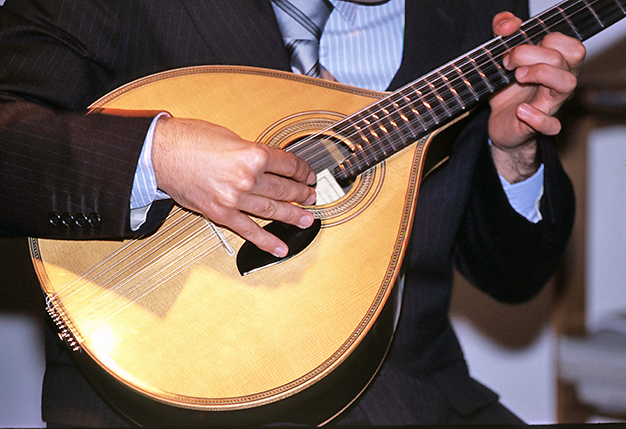
6Drinking & Nightlife
Café Santa CruzCafe
(
MAP
GOOGLE MAP
; ![]() %239 833 617; www.cafesantacruz.com; Praça 8 de Maio;
%239 833 617; www.cafesantacruz.com; Praça 8 de Maio; ![]() h7.30am-midnight Mon-Sat)
h7.30am-midnight Mon-Sat)
One of Portugal's most atmospheric cafes, where the elderly statesmen meet for their daily cuppas. Santa Cruz is set in a dramatically beautiful high-vaulted former chapel, with stained-glass windows and graceful stone arches. The terrace grants lovely views of Praça 8 de Maio. Don't miss the crúzios, award-winning, egg- and almond-based conventual cakes for which the cafe is famous.
You'll pay a bit extra for the atmosphere, but it's worth it. Popular with tourists and locals alike, the cafe also has regular free fado.

AAC BarBar
(Bar Associação Académica de Coimbra;
MAP
GOOGLE MAP
; www.facebook.com/baraac; Av Sá da Bandeira; ![]() h3pm-4am)
h3pm-4am)
Join the black-cape-clad students at their student-union bar, where beers are cheap and everyone is welcome. The esplanade out back, with wood decking and a grassy lawn, makes an agreeable refuge.
Aqui Base TangoBar
(
MAP
GOOGLE MAP
; http://aquibasetango.com; Rua Venâncio Rodrigues 8; ![]() h9pm-4am Tue-Sat)
h9pm-4am Tue-Sat)
This offbeat house holds one of Coimbra's most enticing bars, a quirky space with extremely original decor and a relaxed, inclusive vibe. Music ranges from jazz to alternative rock and there's always something interesting going on or in the pipeline. Gay friendly, too.
O MoelasBar
(
MAP
GOOGLE MAP
; ![]() %962 445 275; Rua dos Coutinhos 14;
%962 445 275; Rua dos Coutinhos 14; ![]() h10pm-4am)
h10pm-4am)
A friendly family-run drinking spot for students – cheap drinks for big (and late) nights. Enough said.

Noites LongasClub
(
MAP
GOOGLE MAP
; ![]() %239 835 167; Rua Almeida Garrett 11;
%239 835 167; Rua Almeida Garrett 11; ![]() hmidnight-6am Mon-Sat)
hmidnight-6am Mon-Sat)
This alternative club plays mainly rock and goes loud and very late. It's not subtle but it's a reliable local favourite. Gay friendly.
3Entertainment
Coimbra has its own version of fado and catching a performance is a must when in town.
Fado ao CentroFado
(
MAP
GOOGLE MAP
; ![]() %910 679 838; www.fadoaocentro.com; Rua Quebra Costas 7; show incl drink €10)
%910 679 838; www.fadoaocentro.com; Rua Quebra Costas 7; show incl drink €10)
At the bottom of the old town, this friendly fado centre is a good place to introduce yourself to the genre. There's a performance every evening at 6pm. Shows include plenty of explanation in Portuguese and English about the history of Coimbra fado and the meaning of each song. It's tourist-oriented, but the performers enjoy it and do it well.
You can chat with the performers afterwards over a glass of port (included).
Á CapellaFado
(
MAP
GOOGLE MAP
; ![]() %239 833 985; www.acapella.com.pt; Rua do Corpo de Deus; entry incl drink €10;
%239 833 985; www.acapella.com.pt; Rua do Corpo de Deus; entry incl drink €10; ![]() hshows 9.30pm daily Apr-Oct, Thu-Sun Nov-Mar)
hshows 9.30pm daily Apr-Oct, Thu-Sun Nov-Mar)
A 14th-century chapel turned candlelit cocktail lounge, this place regularly hosts the city's most renowned fado musicians. There's a show every night at 9.30pm (though it's opening, or otherwise, can be a bit unpredictable).
Shows cater directly to a tourist crowd, but the atmosphere and music are both superb. The setting is as intimate as the music itself, with heart-rendingly good acoustics.
Festival das Artes
This two-week festival in June or July brings classical music to the Quinta das Lágrimas, jazz to the riverboats, guest chefs to local restaurants and other forms of merriment to Coimbra’s streets.
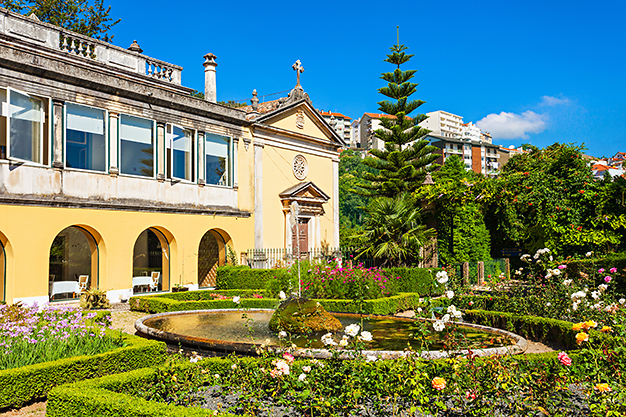
8Information
8Getting There & Away
From the rather grim bus station (
GOOGLE MAP
; Av Fernão de Magalhães) a 15-minute walk northwest of the centre, Rede Expressos (
GOOGLE MAP
; ![]() %239 855 270; www.rede-expressos.pt) runs at least a dozen buses daily to Lisbon (€14.50, 2½ hours) and to Porto (€12, 1½ hours), with almost as many to Braga (€14, 2¾ hours) and to Faro (€27, six to nine hours).
%239 855 270; www.rede-expressos.pt) runs at least a dozen buses daily to Lisbon (€14.50, 2½ hours) and to Porto (€12, 1½ hours), with almost as many to Braga (€14, 2¾ hours) and to Faro (€27, six to nine hours).
Long-distance trains stop only at Coimbra B station, north of the city. Cross the platform for quick, free connections to more-central Coimbra A (called just 'Coimbra' on timetables).
Coimbra is linked by regular Alfa Pendular (AP) and intercidade (IC) trains to Lisbon (AP/IC €22.80/19.20, 1¾/two hours) and Porto (AP/IC €16.70/13.20, one/1¼ hours).
Where to Stay
If you opt for accommodation in the old town, it will be atmospheric, though be aware that parking can be tricky the closer you get to the centre. Thanks to Coimbra's good public transport system, staying out of the city centre is not the hassle you might expect. Student dorms often open their doors to tourists, some year-round.
Coimbra has seen as surge of 'glostels' (let's call them), a mix of very glamorous hostels with dorms and hotel-type rooms. While they're modern, well-equipped and elegant, don't expect full-on hotel services such as 24-hour concierge services.
8Getting Around
Between them, buses 27, 28 and 29 run about every half hour from the main bus station and the Coimbra B train station to Praça da República.
You can purchase multi-use tickets (three/five/10 trips €2.20/3.15/5.80; day ticket €3.50) at the SMTUC office (
GOOGLE MAP
; www.smtuc.pt; Largo do Mercado; ![]() h7am-7pm Mon-Fri, 8am-1pm Sat) at the foot of the elevador, at official kiosks and also at some tabacarias (tobacconists-cum-newsagents). Tickets bought on board cost €1.60 per trip.
h7am-7pm Mon-Fri, 8am-1pm Sat) at the foot of the elevador, at official kiosks and also at some tabacarias (tobacconists-cum-newsagents). Tickets bought on board cost €1.60 per trip.